Are you fond of birds? Did you just spot a small colourful bird in your backyard, and you’re curious to know the details about this bird? You’re exactly at the right place. In this guide, you will discover different types of small birds that you have often seen but never known about their characteristics and where they are found. So, without ado, let us dive straight into it:
House Wren:
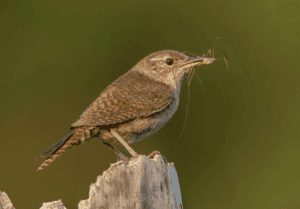
house wren
The House Wren is one of the most favourite small colourful birds. It is a delightful sight in backyards across most of North America.
Here are a few striking characteristics of House Wren:
Characteristics:
- House Wren has a small and compact round body. It has a short tail, often held cocked and a long, thin bill.
- The bird has brownish-grey upperparts with a faint buffy eyebrow. It had white underparts with some barring on the flanks.
Now, how can you recognise this little masterpiece of nature? Here is a unique character of House Wren: This bird is highly Energetic and curious, constantly flitting about and singing a loud, bubbly song.
Size:
4.5-5.25 inches
Where to Find Them:
- House Wrens are common in open woodlands. They are often seen on the edges of forests, gardens, and backyards.
- They readily adapt to human habitats. House Wrens often utilise birdhouses for nesting.
- You can look for House Wren whopping around shrubs, trees, and fences, searching for insects.
House Sparrow :
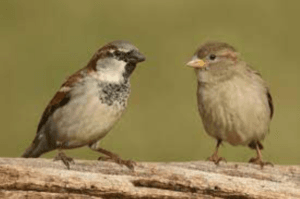
House Sparrow
The House Sparrow, though not as flashy as some other types of small birds. Here are a few distinguishing characteristics of this unique sparrow:
Characteristics:
- House Sparrow has a compact, stocky build with a short tail and a large, rounded head.
- It is Sexually dimorphic (males and females look different).
- The Males of House Sparrows are boldly coloured with a grey crown, black bib and throat, white cheeks, and a rufous (rusty brown) neck patch. Their back is brown with black streaks.
- The Females of House Sparrow are Buffy brown overall with faint streaks on the back and dingy grey-brown underparts. They lack the distinctive markings of the males.
- Both sexes of house Sparrow have a stout, conical beak perfect for seed-eating.
Here is how you can spot House Sparrows easily: A Common and Chatty Companion, often seen in noisy flocks chirping and chattering. This is one of the most common small, colourful birds in North America.
Size:
5.5-7.1 inches
Where to Find Them:
- House Sparrows are true urban dwellers, thriving in human environments.
- They readily build nests in buildings, crevices, birdhouses, and even traffic lights.
- Look for them around houses, buildings, parking lots, parks, and gardens.
- They are ground feeders, often seen hopping around on sidewalks and picking at scattered seeds or crumbs.
Northern Cardinal:
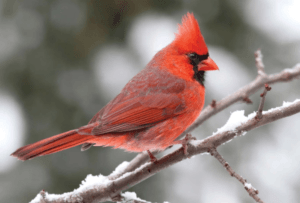
Northern Cardinal
The Northern Cardinal is a beloved resident of backyards across North America. It is known for its vibrant plumage and beautiful songs.
Here’s a closer look at one of the most beloved small colorful birds:
Characteristics:
- Northern Cardinalis is strikingly dimorphic (meaning males and females look different).
- The males of Northern Cardinal are fiery red all over, with a black mask around the bill and a sharp crest on the head. Their thick, cone-shaped beak is a vibrant red-orange.
- The Females of Northern Cardinal are Buffy brown overall with a reddish wash on the wings, tail, and crest. They also have a black mask and a red-orange beak, but not as bright as the males.
If you have ever noticed a vibrant red bird chirping beautifully in your backyard, that is undoubtedly Northern Cardinal.
Size:
7.5-9 inches
Where to Find Them:
- Northern Cardinals are permanent residents. It means they only migrate sometimes.
- They favour backyards, shrublands, forests, edges of woodlands, and dense thickets.
- Look for them perched on branches, hopping on the ground searching for seeds, or flitting between feeders.
- They are particularly active during winter when their bright red plumage stands out against the snow.
American Goldfinch :
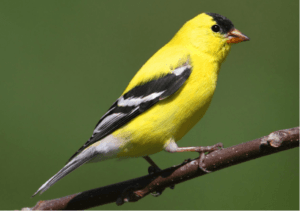
American Goldfinch
These cheerful yellow small birds with black wings and a cap are frequent visitors to feeders, especially in winter.
Here are a few unique characteristics of this beautiful bird:
Characteristics:
- American Goldfinch is a small, slender bird with a long, pointed wingspan and a notched tail.
- It is Sexually dimorphic (males and females look different).
- The males of the American Goldfinch are vibrant yellow all over with a black cap, wings, and tail. They have white wing bars and white patches below the tail. Their small, conical beak turns bright orange during spring.
- The females of American Goldfinch are dull yellow overall with brown streaking on the back, wings, and flanks. They have two faint wing bars and lack the black cap of breeding males. Their beaks are pinkish throughout the year.
- Both sexes of American Goldfinch are acrobatic feeders, clinging to seed heads and flitting about in flocks with a rippling flight pattern. Their sweet, warbling song is a delight to hear.
Here is a unique point to help you recognise the American Goldfinch in your backyard: A Splash of Sunshine in Your Backyard. Yippie! When you see a yellow bird with an acrobatic feeding style, you have spotted the American Goldfinch. small birds
Size:
4.5-5 inches
Where to Find Them:
- American Goldfinches are common year-round residents in open fields, meadows, weedy gardens, backyards, and edges of woodlands.
- They are particularly attracted to feeders filled with nyjer seeds and thistle (their favourites!) but also enjoy sunflower seeds.
Ruby-throated Hummingbird:
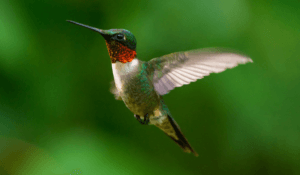
Ruby-throated Hummingbird
The Ruby-throated Hummingbird is a mesmerising sight, a tiny marvel with dazzling colours and incredible flying abilities.
Here’s a closer look at hummingbird’s characteristics:
Characteristics:
- Rubby-throated hummingbirds are Incredibly small (3-3.5 inches) with a long, slender bill and short, forked tail.
- They are sexually dimorphic (males and females look different).
- The males of Rubby-Throated Hummingbirds have an iridescent ruby-red throat patch that appears black in some lighting. Their backs are metallic emerald green, and their underparts are white. They have a dark, almost black, mask around the bill.
- The females of Rubby-Throated Hummingbirds lack the ruby throat patch but have a greenish-white throat with speckles. Their backs are similar to the males, but their underparts are more extensively buffy-white.
- Both sexes have swift wings that beat so rapidly they appear to blur!
Here is how you can recognise this tiny bird if you spot a tiny, beautiful bird with a Jewel on the Wing. Congrats! You spotted a Ruby-throated Hummingbird.
Size:
3-3.5 inches
Where to Find Them:
- Ruby-throated Hummingbirds are summer visitors to eastern North America, migrating south to Central America for the winter.
- They favour gardens, backyards, and woodlands with plenty of flowering plants, especially red or orange tubular flowers.
- You can Look for rubby-throated hummingbirds flitting around flowers, sipping nectar with long, extendable tongues. They may also be seen at feeders filled with sugar water, mimicking their natural food source.
Indigo Bunting
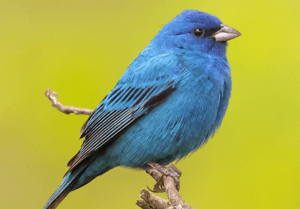
Indigo Bunting
The Indigo Bunting boasts a flash of electric blue plumage for the males. Here are a few characteristics to discover this hidden gem in your backyard:
Characteristics:
- Indigo blunting is small and slender with a long, pointed tail and a conical beak.
- They are sexually dimorphic (males and females look different).
- The males of Indigo blunting are stunning electric blue with black wing bars and a dark mask around the bill.
- The females of Indigo blunting are brownish-grey overall with faint streaking on the back and underparts. They lack the vibrant blue plumage of the males.
- Both sexes of Indigo blunting are shy and secretive, preferring dense shrubbery and edges of woodlands. Their sweet, warbling song is often their only giveaway.
There are thousands of tiny, tiny birds, so how will you spot Indigo Bunting? If you have a Flash of Blue small bird on your terrace, it’s Indigo Bunting.
Size:
5-5.5 inches.
Where to Find Them:
- Indigo Buntings are summer visitors to the eastern half of North America, migrating south to Central and South America for the winter.
- They favour shrubby areas, edges of woodlands, and overgrown fields.
- You can Look for them perched low in dense vegetation, flitting from branch to branch, or singing from hidden perches.
Blue Jay:
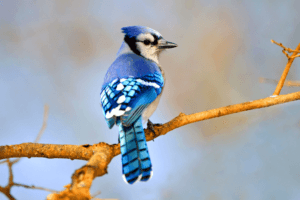
Blue Jay
Blue Jay is the bold and bossy beauty of the backyard. The Blue Jay is a large, striking bird with a bright blue crest, black bib, and a loud, unforgettable call.
Characteristics:
- The Blue Jay has a large and stocky body with a strong, hooked beak and a prominent crest on the head.
- It has striking colouration with bright blue upper parts, a white chest and underbelly, a black bib and collar, and white markings on the wings and tail.
- Blue jays are Intelligent and vocal birds known for their loud calls and harsh screams.
- They are bold and aggressive at feeders, often chasing away smaller birds.
Do you see small bird photos that recognise Blue Jay? It is easy, dont stress. One of the striking features of Blue Jay is a bold and bossy beauty with a large size and an unforgettable, loud voice.
Size:
11.8-12.6 inches
Where to Find Them:
- Blue Jays are permanent residents across most of North America.
- They favour woodlands, parks, backyards, and edges of forests.
- You can look for them perched on high branches, watching for food, or making a racket at feeders.
- Blue Jay is also known for their acrobatic foraging skills, which include hanging upside down to reach nuts and seeds.
Cedar Waxwing:
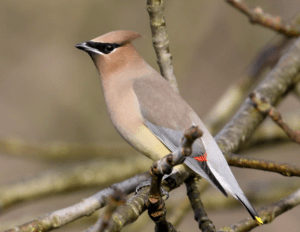
Cedar Waxwing
The Cedar Waxwing is a medium-sized, social bird with a rufous belly and distinctive waxy red wing tips.
Here are a few distinctive features of this waxy bird:
Characteristics:
- The Cedar Waxwing is a medium-sized bird with a sleek body, broad wings, and a prominent crest on the head.
- Thr cedar waxwing is Brownish-gray overall with a rufous (rusty brown) belly and a black mask around the eye.
- Cedar Waxwing has distinctive waxy red tips on some wing feathers and a yellow band on the tail tip.
- They are known as Social birds, often seen in flocks, especially during winter, when they erupt in chattering calls as they move from tree to tree.
Do you just spot a small colourful bird and striking your head, wondering how to recognise this small bird? We have a solution for you if the bird is sleek with Waxy red wing tips. Yes, you spotted a Cedar waxwing bird!
Size:
7-8 inches
Where to Find Them:
- Cedar Waxwings are nomadic birds throughout North America year-round, but their movements can be unpredictable.
- You can look for Cedar Waxwing perched on branches, feasting on berries.
- You can also find Cedar waxwing flying in loose flocks with a rolling flight pattern.
Chipping Sparrow:
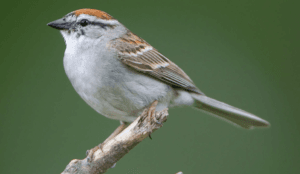
Chipping Sparrow
The Chipping Sparrow is a widespread small bird known for its short, high-pitched trill.
Here’s a closer look at these delightful songbirds that you might often see in your backyard:
Characteristics:
- Chirping sparrows are small, slender birds with long, pointed tails and thin bills.
- They are sexually dimorphic (males and females look different).
- The males of chirping sparrows have a reddish-brown cap, a white eyebrow stripe, and a black line through the eye. Their back is brown with streaking, and their underparts are greyish-white.
- The Females are duller overall with less prominent markings. They lack the reddish cap and have a faint eyebrow stripe.
- Chirping Sparrows are active and ground-foraging.
- These birds often flick their tails as they search for seeds and insects.
If you see a small bird chirping beautifully in your backyard, flicking its tail in search of food. Yes! You spotted a chirping sparrow.
Size:
4.7-5.9 inches
Where to Find Them?
- Chipping Sparrows favour open fields, meadows, edges of woodlands, and backyards with brushy areas and scattered seeds.
- You can look for Chirping Sparrowshopping on the ground, perched on low branches, or flitting in loose flocks.
We hope this list of 10 Small birds helps you spot your favorite small bird. Stay connected with us to know more about animals and birds.
